Perchè pensa in maniera innovativa: un esempio …
More and more journalists use blogging platforms to write and edit stories, but those text editors are pretty basic: It’s not easy to see what changes others have made to a post. And two people can open the same post, overwriting one another’s edits.
The New York Times has solved those problems for online journalists by building a tool that will track changes in a browser-based text editor. The tool, called ICE (for Integrated Content Editor) was built so that it will work with a variety of text editors; the Times has already built plugins for WordPress and TinyMCE, a common text editor used in blogging platforms. (The New York Times Company is an investor in Automattic, the company that develops the WordPress blogging platform.) In effect, the Times has combined the ubiquity and ease-of-use of brower-based text editors with the accountability and scale of newspaper word processing systems.
…
So the Times developers decided to add on to existing text editors out there by creating a tool to track changes.
A demo of the Times’ text editor shows how it works. Changes made by different users are marked with strikethroughs or highlights. A user can press a button to accept or reject a particular change or all of them. It looks a lot like revision tracking in Microsoft Word.
ICE is more sophisticated than the “track revisions” function in WordPress, which shows the previous version of a story but doesn’t highlight the exact changes. And while WordPress shows those revisions on another screen, with ICE they appear in the text editing window, right where you add links and boldface text.

